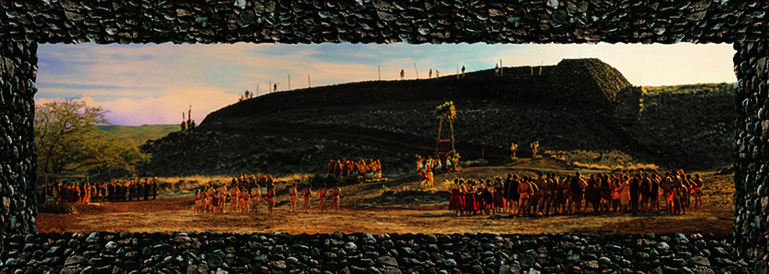 This photograph shows people gathered in front of the heiau soon after sunrise. During the darkness before dawn at 5 a.m. the men in their malos (loin cloths) and ceremonial capes, went up to the large heiau and began prayers and women went to the lower heiau down to the left. The prayers, chanting and meditation continued until, to the chant of E Ala E, the sun breached over the edge of the upper heiau. Then began the procession you see here as the Ku ki‘i (image) and kahili (feather
This photograph shows people gathered in front of the heiau soon after sunrise. During the darkness before dawn at 5 a.m. the men in their malos (loin cloths) and ceremonial capes, went up to the large heiau and began prayers and women went to the lower heiau down to the left. The prayers, chanting and meditation continued until, to the chant of E Ala E, the sun breached over the edge of the upper heiau. Then began the procession you see here as the Ku ki‘i (image) and kahili (feather
standards) are brought in procession from the top of the heiau where they will be placed between the two
sun-highlighted mahioli at the bottom of the path. The larger wooden structure is a lele,
a wooden altar upon which offerings will be placed as you will see below.
Pu‘ukohola Heiau National Historic Site, Kawaihae Bay, Hawai‘i Island
Photographs © by Tom Whitney - see note below on use of photographs.
This is the place in Kawaihae on the big island of Hawai‘i known as Pu‘ukohola, The
Mound of the Whale. It is the primary structure associated with the founding of the
Kingdom of Hawai‘i. Starting with a renewal in 1991, it has been a place where
all are summoned to ho‘okuikahi (unite as one), and to continue the legacy of
Hawai‘s first king, Kamehameha Nui. To, in his dying words, "E na‘i wale
no ‘oukou, I ku‘u pono ‘a‘ole I pau," (strive to pursue my unfinished good
deeds). Every year in mid-August Hawaiians gather for three days to re-
connect, rediscover and rekindle their character and identity and fulfill
their responsibilities of their past. Here Hawaiians are welcomed to be
inspired and participate in cultural awakenings through chant, hula,
ha‘a and ho‘oikaika kino (physical strength demonstrations) to
celebrate Ke Kulana No‘eau O Ka Wa Kahiko
(The Culture of Ancient Hawai‘i).

 The women of Na Wa‘a Lalani Kahuna (right) chant on the flats of Pu‘ukohola, Hawai‘i, in 2002. Directly behind them stands the Hale Mua (holding spears), and to the left in the foreground is Na Koa Kau i ka Meheu o na Kupuna. On the perimeter of the ceremonial space (background, from left to right, ascending) are onlookers, female participants from Na Wahine Kauhi a Kama and Na Koa (under the makeshift shelter), teachers and students from the Kanu o ka ‘Aina Charter School, and members of halau hula. This caption was written and copyrighted by Ty P. Kawika Tengan, who wrote the book "Native Men Remade, Gender and Nation in Con-temporary Hawai"i," the cover of which you see on the left. It was published by the Duke University Press. Tengan has been a participant for years in these events and his book is one of the best introductions to contemporary Hawaiian culture available today. It can be ordered at Amazon.com.
The women of Na Wa‘a Lalani Kahuna (right) chant on the flats of Pu‘ukohola, Hawai‘i, in 2002. Directly behind them stands the Hale Mua (holding spears), and to the left in the foreground is Na Koa Kau i ka Meheu o na Kupuna. On the perimeter of the ceremonial space (background, from left to right, ascending) are onlookers, female participants from Na Wahine Kauhi a Kama and Na Koa (under the makeshift shelter), teachers and students from the Kanu o ka ‘Aina Charter School, and members of halau hula. This caption was written and copyrighted by Ty P. Kawika Tengan, who wrote the book "Native Men Remade, Gender and Nation in Con-temporary Hawai"i," the cover of which you see on the left. It was published by the Duke University Press. Tengan has been a participant for years in these events and his book is one of the best introductions to contemporary Hawaiian culture available today. It can be ordered at Amazon.com.
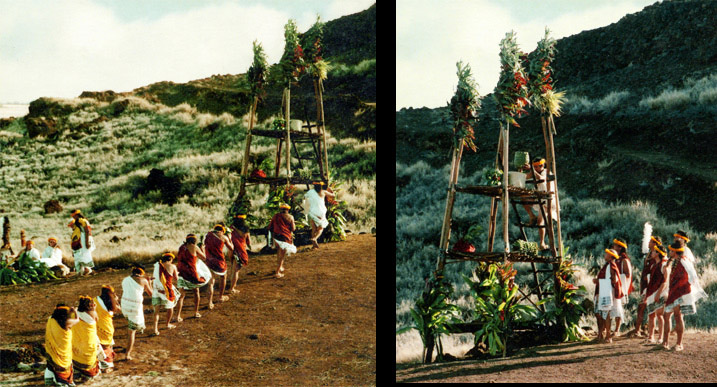

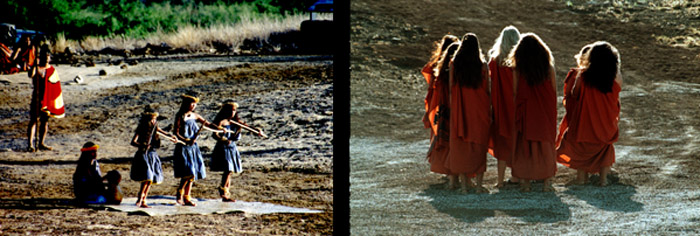
People bring ho‘kupu (offerings) of all kinds. Some chant or do hula and others bring items of plant origin representing
the various gods of Hawai‘i that are manifest in various plants that convey the types of prayers they are making.
No meat, coins, trinkets. The ho‘okupu are placed at various levels on the lele depending on their purpose.
The highest level of the lele is for prayers to go far and to the gods, lower levels for those
relating to nearby family, the land and local situations.
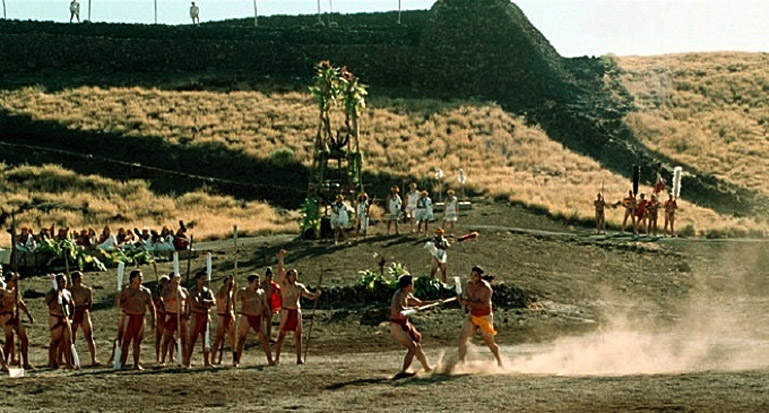
 Ty Tengan's caption for this photograph as it appeared in his book "Native Men Remade" and used here with permission is this: "The men of Hale Mua and Na Koa Kau i ka Meheu o na Kupuna face off in a sham battle, Pu‘ukohola, Hawai‘i, 2002. Participants take care to embrace and affirm friendships at the end of individual matches, as the two men on the far left of the frame are doing. Men of NaWa‘a Lalani Kahuna (in background, above to the right) stand at the base of the lele (three-tiered
Ty Tengan's caption for this photograph as it appeared in his book "Native Men Remade" and used here with permission is this: "The men of Hale Mua and Na Koa Kau i ka Meheu o na Kupuna face off in a sham battle, Pu‘ukohola, Hawai‘i, 2002. Participants take care to embrace and affirm friendships at the end of individual matches, as the two men on the far left of the frame are doing. Men of NaWa‘a Lalani Kahuna (in background, above to the right) stand at the base of the lele (three-tiered
altar) and watch the sham; women from the group are seated (to right, barely visible through the dust
cloud). This image was featured in the Hana Hou! magazine of Hawaiian Airlines."
These captions for me, the documentary photographer, reinforce my contention that cultural photographs
need good captions that go into some detail, otherwise they are just not understood. The words are an essential
part of the documentation. You will see this more in the section on this website related to the Manuna Kea exhibition.
Plenty of words there, as written and spoken by Hawaiians, as I was closer to that process, as Tengan has been to this one.
– Tom Whitney


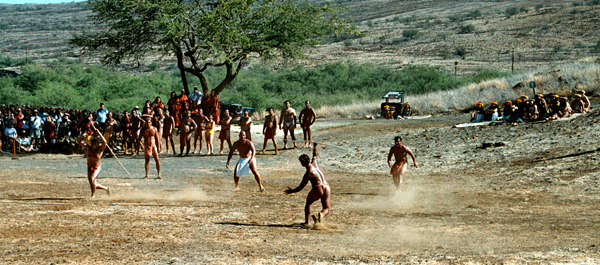
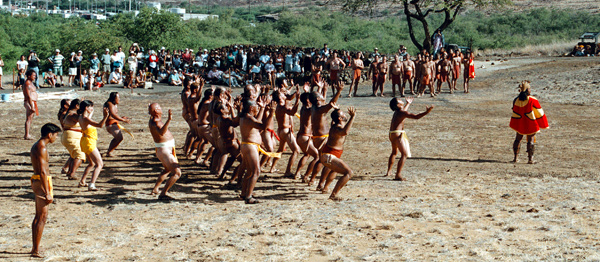
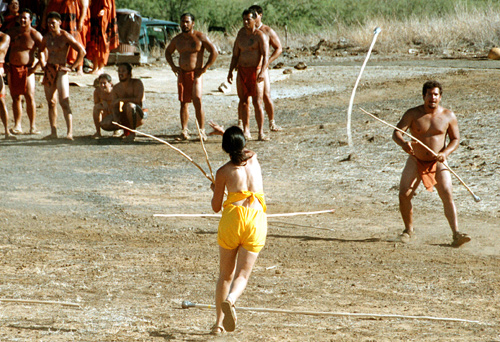
Each year there are different physical skill competitions among groups from the different
islands. There is keen competitiveness and some jeering at times to spice things up. Women participate
as do young people. In the photograph immediately above the woman in yelliow was holding her own quite well
as her spear hits on a couple of men caused them to be eliminated from the competition.
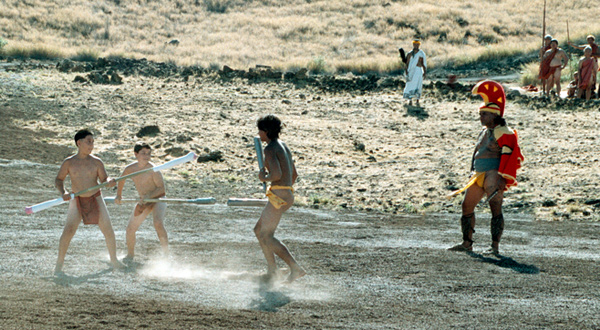



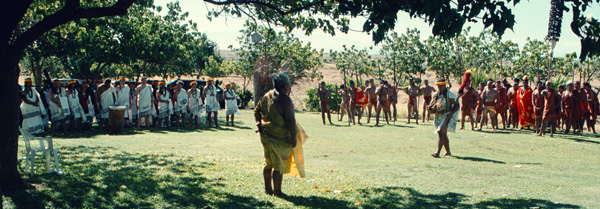


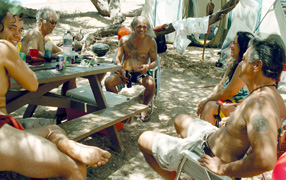
It is a time for reconnecting, learning craft skills, meeting old friends, singing,
participating in the various ceremonies and rituals that bind people to the culture and
for the just plain fun of hanging out together and camping out in Spencer Park for a few nights.
The bottom photograph shows members and friends of the Pihana ‘Ohana having a good time.
Note on use of the photographs:
You are welcome to use or print these photographs for educational or personal purposes.
Use of the material for
commercial purposes or in situations where fees are usually paid is prohibited unless you obtain permission by
by emailing Tom Whitney (whitneye001@hawaii.rr.com). My ethic is to split 50:50 any income from
the photographs above the cost of producing the pictures with the person or group in the
photographs. My hope is that more Hawaiians will be motivated to attend these
ceremonies after seeing the photographs and others will be moved to buy
Ty Tengan's book described above to better understand them.

